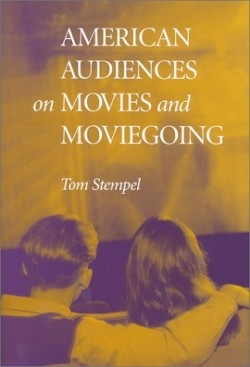American Audiences on Movies and Moviegoing
Double features at the Rialto. Teenage rites of passage at the local drive-in. Taking children to revivals of old favorites. The movies have been a staple of American leisure for generations.
Stempel, a professor of film studies, has assembled the perceptions and experiences of dozens of people about movie going. These observations, mixed with the author’s interpretations, are the result of questionnaires (included in the appendix) distributed to friends, acquaintances, and students. The results, therefore, may not be what the reader considers “average,” although they fairly reflect the ideas of anyone who has ever sat down with an overpriced combo of popcorn and soda: some movies are great, others are stinkers, and when it comes right down to it, the opinions of professional critics don’t amount to a hill of beans.
The respondents all agree on one thing: the “magic” of the big screen. One subject could represent the group when she wrote, “I realized the power that movies can have over all of us. The ability to reach the poor, the rich, the father that had to work three jobs to support a family. It was almost like a miracle worker.”
In general, the interviewees fall into two camps: those who hold the films in the same high regard as when they first saw them, and those who are amazed to find they actually liked this stuff at one point. The chapters are divided into genres and time frames, primarily from the 1950s on. There is no general contemplation of two standards of American film, the western (save for a chapter about Clint Eastwood) and film noir / gangster flicks.
Among Stempel’s considerations are the impact of watching a movie on television and videotape as opposed to the movie theater “experience,” with its huge screen, amplified sound and, of course, the members of the audience, who often feed off each other for validation of their opinions. He and the survey respondents also discuss various directors, with a special emphasis on the influence of Steven Spielberg, as well as how trailers (a.k.a. “coming attractions”) can mean the difference between a movie’s success or failure.
One of the more noteworthy perceptions is how a movie’s impact can change over the years. A film such as The Exorcist might not carry the same impact now as it did twenty-five years ago. The same could be said for such historically perceived classics as Citizen Kane or Casablanca. As Stempel puts it, simply, “Times change, things change.” Hopefully, some things remain constant. Among them, America’s continued love for, and fascination with, the movies.
Reviewed by
Ron Kaplan
Disclosure: This article is not an endorsement, but a review. The publisher of this book provided free copies of the book to have their book reviewed by a professional reviewer. No fee was paid by the publisher for this review. Foreword Reviews only recommends books that we love. Foreword Magazine, Inc. is disclosing this in accordance with the Federal Trade Commission’s 16 CFR, Part 255.

